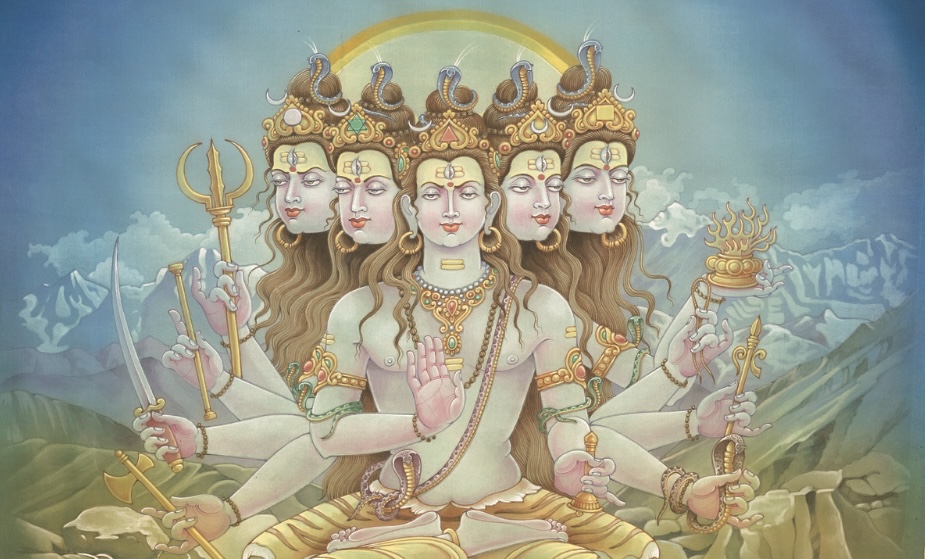The Vedas decree that god created the world, and it is true, he did; but that is a simplistic rendering of a mind-bogglingly complex event. It would be like saying a child grows from two microscopic cells. It is true. But looking deeper, both processes are exquisitely magical and complex beyond belief. The growth of two cells into a human being of 100 trillion cells is a process capable of bringing tens of thousands of scientists to their knees. Imagine, then, comprehending the evolution of the entire universe, from God and of God, filled with 100 trillion galaxies. But understanding God’s acts of creation, preservation, dissolution, concealment and revelation is exactly what the ancient Hindu seers undertook, aided, they would say, by the Agamas, sacred texts composed by God Himself. With more than a little trepidation, we undertake to bring forth a summary of what they teach of God and His powers. We were taxed to do this, and we have no doubt the reader will be similarly challenged to comprehend it all, though we hope our several charts will provide an overview of some textual complexities. Still, this central and profound part of ancient India’s understanding of our cosmos and our innermost being is well worth the effort. It will give the Hindu priest enhanced insight into the deeper meanings of the temple puja. It will give the advanced meditator new ways to explore the subtle dimensions, the superconscious mind of God within. It will give theologians grist for their philosophical and cosmological mills. It will likely give everyone else a headache.
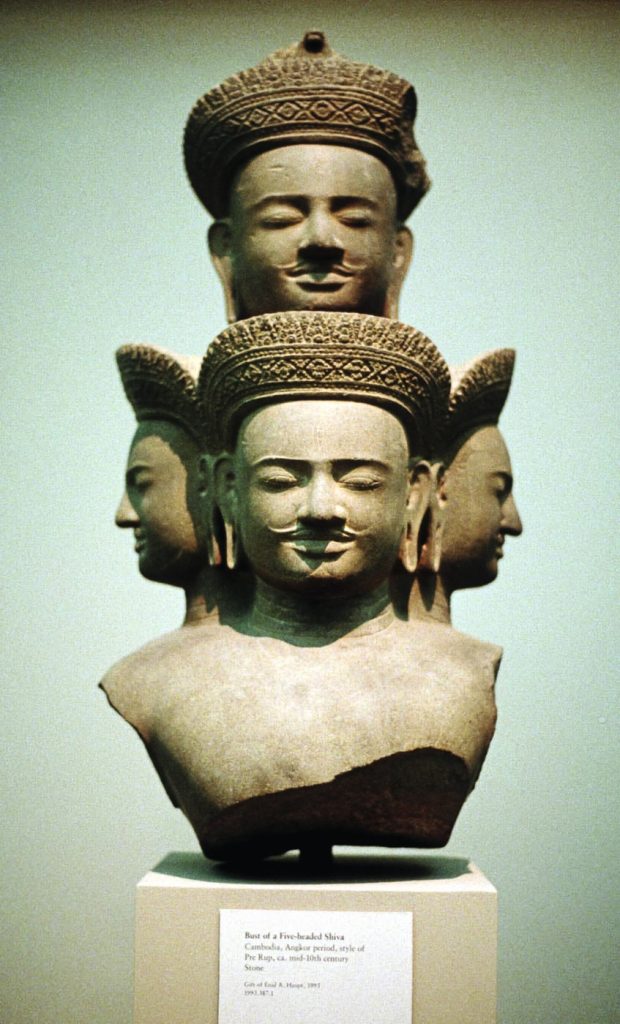

called Sadasiva, the ever auspicious Lord, sitting in the high Himalayas at the
source of the river Ganga, with Her waters pouring off the page. The five faces
(from left to right) are Ishana, Tatpurusha, Aghora, Vamadeva and Sadyojata. They
radiate, in order, revealment of grace, sublimation of the five senses, omnipresence,
omnipotence and omniscience. This sequence is the creative cycle, when reversed
the cycle of dissolution is depicted. The five-hooded snakes indicate the need
to exercise caution, use wisdom, resist temptation, move carefully and use
discrimination. His ten arms denote the consummate ability to tackle difficulties.
His hand raised in blessing, facing forward, carries the message “Have no fear;
you will attain liberation.” Four faces are said to have revealed the Vedas; the
fifth (Ishana) revealed the Agamas. Each face bears a geometric shape above the
forehead which represents one of the five elements and identifies the Lord. He sits
on a tiger skin which blocks worldly vibrations that keep devotees earth-bound.
INTRODUCTION
THE FIVE POWERS OF SIVA
By Satguru Bodhinatha Veylanswami
Lord Siva is commonly thought of as the god of destruction, one Divinity among a divine trinity, along with Brahma, Lord of Creation, and Vishnu, Lord of Preservation. This theological perspective, especially espoused in Smarta Hinduism, is based in the Puranas, Hindu folk narratives containing ethical and cosmological teachings about Gods, man and the world. But other denominations, including Saiva Hinduism, which is based on the Saiva Agamas, hold a different view. In these revealed scriptures the three great cosmic actions are all performed by God Siva. In addition to creation, preservation and destruction, Siva performs two more actions which relate specifically to the soul. With the fourth, called obscuration, He veils Himself from us, the embodied souls, purposefully limiting our awareness, keeping us ensconced in the world–oblivious to our true nature, our past and future lives and karmas–thus allowing us to evolve. This beguiling force is called veiling or concealing grace, tirodhana shakti. With His fifth action or power, called revelation, anugraha shakti, Lord Siva frees us from the illusion of separateness from Him, granting us realization of our true identity. The Raurava Agama proclaims: “The birth of the world, its maintenance, its destruction, the soul’s obscuration and liberation are the five acts of His dance.”
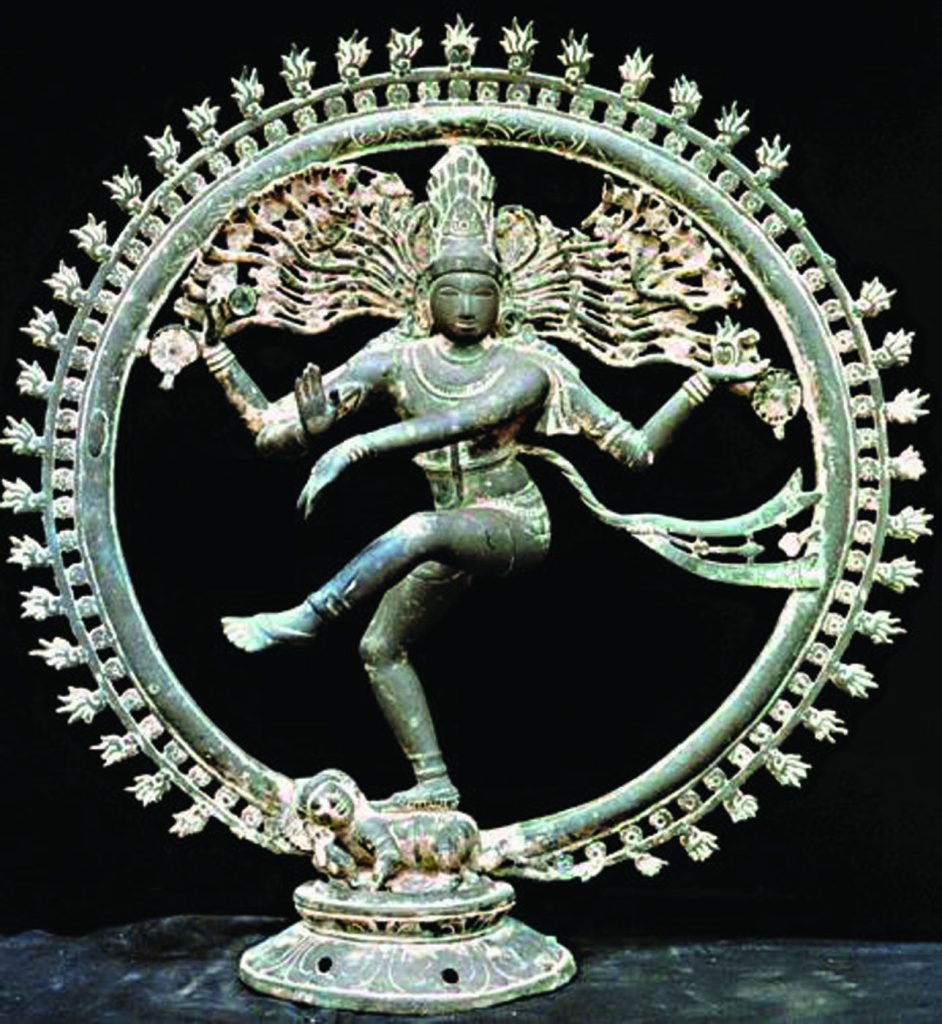
Siva Nataraja, Lord of Dance, a well-known murti (worshipful icon), clearly depicts these five actions. Creation, or emanation (srishti), is represented by His upper right hand holding the drum upon which He beats Paranada, the Primal Sound, from which issue forth the rhythms and cycles of creation. Preservation (sthiti) is represented by His lower right hand, held in the gesture of blessing, abhaya mudra, indicating “fear not.” Destruction (samhara), dissolution or absorption, is symbolized by the fire in His upper left hand, held in ardha-chandra mudra, “half-moon gesture.” Obscuring grace (tirodhana), the power which hides the truth from souls, thereby permitting experience, growth and eventual fulfillment of destiny, is represented by His right foot upon the prostrate person, apasmarapurusha, who symbolizes the principle of ignorance, or anava. Revealing grace (anugraha), which grants knowledge and severs the soul’s bonds, is symbolized by Siva’s raised left foot, and by His lower left hand, held in gajahasta or “elephant trunk” mudra, inviting approach.
Little known to the general public, but quite well known to the Saivite priesthood, is another form of God Siva performing these five actions. This form of Siva has five faces and is called Sadasiva. In Sanskrit the five faces are referred to as Panchabrahma, meaning “five great Lords.” The term Brahma in this context does not refer to the four-faced creator God (Brahma). A description of Panchabrahma is given in the Ajita Agama (20, 158-164a) in the form of instructions to temple priests:
“After thus constructing mentally the throne of Siva, holding a handful of flowers, with steady mind and controlled senses, one should meditate on Siva’s body sitting in the lotus posture, shining with the color of pure crystal, endowed with five heads, serene, with smiling faces, having the brilliance of ten million suns, of new full-blown youth, with ten arms, brightened by a crest of tawny tresses rolled upwards, each face having three radiant eyes, or shaktis, with the crescent moon of wisdom in His hair, the cause of all causes, His right hands holding the no-fear posture, a trident, an axe, a sword and a thunderbolt, His left hands holding a noose, a serpent, an elephant goad, fire and a bell, all fit for a supreme sovereign, endowed with every auspicious mark, adorned with ample ornaments, in radiant raiments, attractive, having beautiful garlands and an ointment of sandalwood paste.”
In his commentary on Mrigendra Agama, Aghorasivacharya (12th century) is careful to point out that while we speak of Siva with five faces and many limbs, He does not actually possess these features. This visualization in only for the sake of meditation and adoration.

wields the power of creation. His direction is west, He is related to the sphere of earth
(prithivi mandala) and His Panchakshara Mantra syllable is Na. The Agamas describe Him as
white in color, in the likeness of a boy with a charming face, besmeared with sandalwood
paste, adorned with white flowers. One hand displays the boon-granting varada mudra and
another the fear-not abhaya mudra. He is Siva manifest in all of nature; the causer of birth.
In Saiva Siddhanta philosophy, Lord Siva, God, is All and in all, and is understood in three modes: formless (nishkala), formed-formless (sakala-nishkala), and formed (sakala). In the formless mode, Siva is Absolute Reality, Parasiva; in the formed-formless mode, Siva is Pure Consciousness, Parashakti; in the formed mode, Siva is Personal Lord, Parameshvara. Siva is represented in the main shrine of nearly all Siva temples as the Sivalinga. This aniconic murti represents the formed-formless aspect of God. Metaphysically, the Absolute Reality, Parasiva, which is formless, comes to be known as Sadasiva when He presents Himself in the Sivalinga. Sadasiva means eternally pure and auspicious. In temple ceremonies (puja) based on the Saiva Agamas, it is this five-fold form of Siva that is being worshiped in the Sivalinga. To show this, some temples include in their decorations a metal covering over the Linga with four faces engraved in it. The fifth face, Ishana, may be shown on the top, but is most commonly omitted. Some Sivalingas have the faces carved into the Linga itself. The Ishana face looks upward and is of pure crystal color. Tatpurusha faces east and is gold in color. Aghora faces south and is blue-black in color. Vamadeva is turned northward and is saffron in color. Sadyojata looks west and is white in color. In some temples, Panchabrahma is also represented by five distinct murtis displayed in a prominent place, such as on the outside of the main tower above the sanctum.
In the Ajita Agama, Sadasiva is said to be formed-formless because His body is made up of five mantras. In Sanskrit, this etheric vessel is termed vidyadeha or “knowledge body.” The five mantras, known collectively as the Panchabrahma Samhita Mantra, are: Ishana Murdha, Tatpurusha Vaktra, Aghora Hridaya, Vamadeva Guhya and Sadyojata Murta. At the subtle level at which Sadasiva exists, there is still not a definite body in form, only the seeds or potentialities of sound, color and knowledge.
In his introduction to the Ajita Agama, Pierre-Sylvain Filliozat, offers insight into Sadasiva in Saiva Siddhanta: “Saivism is a religion of one God, the supreme Siva (Parasiva). Numerous entities are around Him. They are His creations and consequently His subjects with definite functions. They participate of His own essence in different degrees. The major ones among them are said to be engendered by Him or to be outward manifestations of Himself. We use the word hypostasis, or “sub-state,” to refer to the concept of emanation of a subsidiary entity from the Supreme, as it expresses in the most general way the idea of existence separated from the essence without altering the unity of the latter…. The reason given for the fact of hypostasis of the Supreme God is the necessity of communication. The Supreme is characterized as inaccessible to senses, speech and mind. That would render worship impossible. The Supreme makes Himself accessible through accessible hypostases. In the Saiva religion, the main hypostasis is Sadasiva; and Saiva worship is precisely the worship of Sadasiva. The communication with the entity comes through five Brahma mantras, which are formulas of homage to five entities: Ishana, Tatpurusha, Aghorasiva, Vamadeva and Sadyojata. Communion is realized through the mental image of five heads, bearing the same names and placed, respectively, at the zenith, in the east, south, north and west. The basic action of the worshiper is meditation (dhyana) on these five heads. Meditation and bodily actions need a point of fixation (dharana), a material support and target. This is the Linga, a name given in the Ajita Agama only in its sense of ‘sign.'”
Editor’s Note: The term Parasiva, used by Bodhinatha above to mean Absolute Reality, carries the additional meaning of Siva as Mahadeva in the main text.
THE STORY OF CREATION
THE PROCESS OF GRADUAL MANIFESTATION OF THE PRIMAL AND UNCAUSED LIGHT
By Sabharathnam Sivacharyar
From the Saiva Agama scriptures, we gain a profoundly detailed explanation of the process by which the universe unfolds. The following is a lucid summary of such discussions in the Kamika Agama, Vatula Agama, Raurava Agama and Kalottara Agama.
Siva, in His fullness, is supreme consciousness with the effulgence of trillions and trillions of suns. Should that intensity be directly manifested, the worlds would be incinerated, and thus there exists a gradual descent of His presence, leading indirectly to Karma Sadakhya, the form worshiped as the Sivalinga.
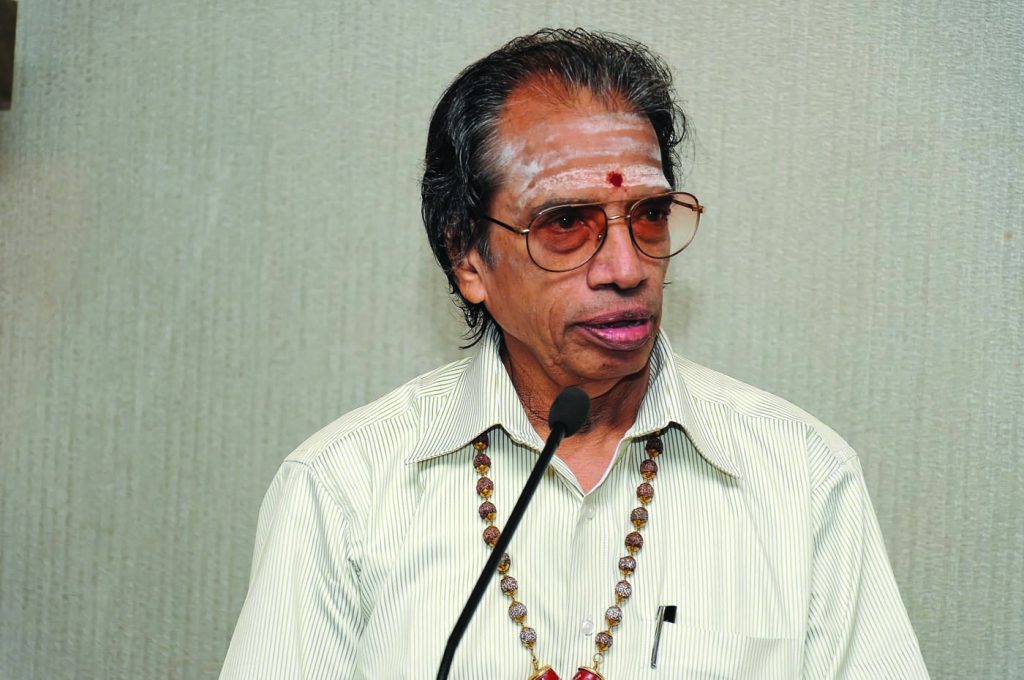
Siva assumes innumerable forms in order to regulate the movement of the worlds and to liberate embodied souls. Some of these divine forms are momentary, such as those seen in visions by devotees, saints and sages; and others are eternal, such as Dakshinamurti and Siva as vanquisher of demons. Temporary and eternal forms of Siva all arise from the Sivalinga enshrined in Siva temples. Thus, the Shilpa Shastras categorically call the Sivalinga the primal image (mula bimba). The greatness and significance of Sivalinga can be understood only by understanding the order in which these transcendental manifestations are taking place.
COSMIC CREATION
Lord Siva, existing in His blinding self-effulgence and love, creates countless souls, an act that is likened to sparks issuing from a blazing fire. Initially souls are incorporeal and enshrouded in the darkness of ignorance. That this veiling darkness may be understood and dissolved, souls need to be embodied in various worlds where they can experience both merits and demerits. Different forms of the Supreme God are necessary for them for the purpose of contemplation and worship. The Agamas speak of a motherly compassion spontaneously arising within Lord Siva to redeem and uplift the shrouded souls, a divine desire (iccha) resulting in a minute impulse or movement (kshobha) within Him. It is from this vibration, this divine love, that manifestation in its myriad forms appears.
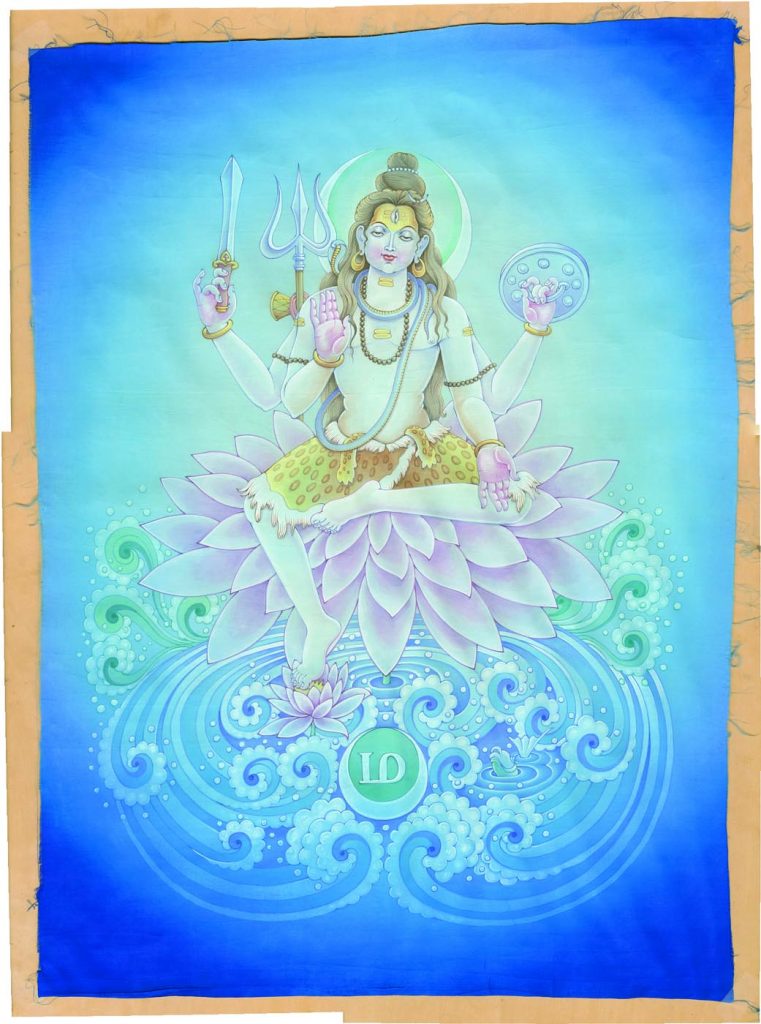
power of preservation. His direction is north, He is related to the sphere of water (jala mandala), and His
Panchakshara Mantra syllable is Ma. The Agamas describe Him as red in color, with a handsome face and
aristocratic bearing, wearing rich apparel, a turban and garlands of flowers. He holds a sword and a shield.
That impulse of creativity brings forth a pulse, or Shakti, called Parashakti, which is one thousandth of Parasiva’s brilliant radiance. Next, another Shakti, called Adishakti, arises as a thousandth of Parashakti. Next, Icchashakti manifests as one one-thousandth of Adishakti. Then Jnanashakti arises as one tenth of a hundredth of Icchashakti. Finally, Kriyashakti arises as a thousandth of Jnanashakti. Each Shakti is less subtle than the Shakti from which it arises. These five Shaktis are all transcendental and formless, never depicted as images, only contemplated upon.
Parashakti, profoundly subtle, all-pervasive and immeasurably effulgent, conceives the process of five-fold cosmic function. Adishakti, exceedingly brilliant, pervades embodied souls, as well as liberated souls. Icchashakti, greatly luminous, begins the process of creating the worlds and various bodies for the souls. Jnanashakti illuminates the Deities protecting the worlds and souls living in various planes of existence. Kriyashakti instills power and ability in the cosmic authorities that perform the five-fold cosmic function.
In this same transcendental space, five Sivas manifest, each related to one of the five Shaktis and collectively called the Panchasivas: Anashrita, Anatha, Ananta, Vyomarupa and Vyapaka. Anashrita appears as one part out of a thousand parts of Parasiva. In the same way, Anatha arises out of Anashrita, Ananta out of Anatha, Vyomarupa out of Ananta, and Vyapaka out of Vyomarupa.
EMERGENCE OF THE FIVE SADAKHYAS
Next, each of the five Shaktis merges with its corresponding Siva. Upon the union of Parashakti and Anashrita, a form called Siva Sadakhya appears, flashing forth incessantly with the radiance of thousands of lightning bolts. It emerges as one of ten parts of Parashakti. This is the first and fundamental tattva, which serves as the causal source for the evolution of all other tattvas. Sadakhya means that which is always pure and auspicious, undefiled by external or internal impurities and dispositions.
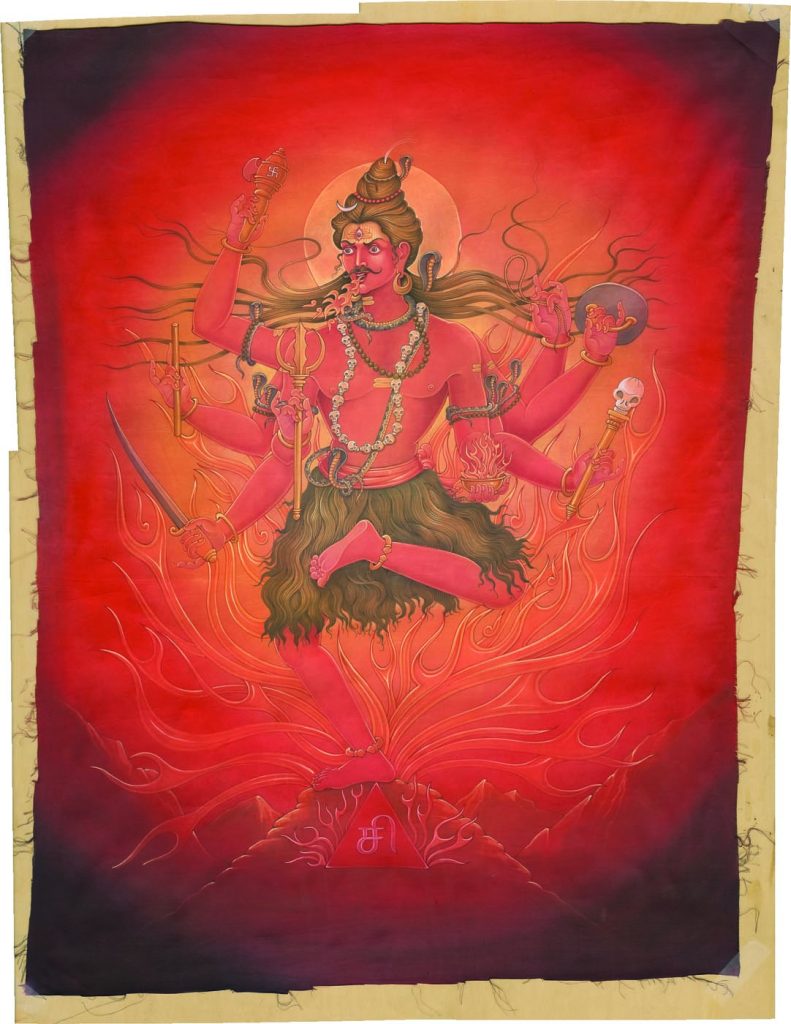
power of dissolution. His direction is south, He is related to the sphere of fire (agni mandala),
and His Panchakshara Mantra syllable is Si. The Agamas state that Aghora Deva is the color
of dark cloud and is adorned with crescent studded crown and beautiful earring. Though His
expression is pleasant, His appearance is dreadful, with long, projecting teeth, and a tawny
colored beard, moustache and matted hair. He is adorned with snakes and scorpions and a
garland of skulls. The four hands on the left side hold a fire, khatvanga (a staff with a skull at its
top), shield and noose. The four hands in the right side hold a trident, hatchet, sword and staff.
From the union of Adishakti and Anatha arises Amurti Sadakhya, as one tenth of Adishakti. It is likened to a fiery pillar with the brilliance of millions of suns. In the middle of that pillar is the vibrant presence of a luminous Linga called Divyalinga. Amurti Sadakhya, also called the primal pillar (mula stambha), serves as the source form for the occurrence of evolution and dissolution.
The union of Icchashakti and Ananta results in the emergence of Murti Sadakhya, comprising one-tenth of Icchashakti. It shines forth in the form of a fiery Linga, a blazing conflagration (kalagni), at the time of final dissolution (mahapralaya). In the upper part of that luminous Linga is a form with one face and three eyes, four hands, holding a deer, a hatchet and displaying the compassionate varada mudra and the fear-not abhaya mudra. This Sadakhya form, too, is not depicted as a visible image. It is to be contemplated only.
The union of Jnanashakti and Vyomarupa gives rise to Kartru Sadakhya as one-tenth of Jnanashakti. Kartru Sadakhya has the form of a crystal (sphatika) Linga, in the middle of which appears a beautiful, luminous form with four faces, twelve eyes, four colors, eight hands and two feet. The four hands on the right side display a trident, axe, sword and abhaya mudra; the four hands on the left side display a noose, snake, bell and varada mudra.
The union of Kriyashakti and Vyapaka gives rise to Karma Sadakhya as one-tenth of Kriyashakti. This is the most important Sadakhya form. It is in this form that the Linga and the pedestal (pitha) of the Sivalinga appear for the first time. The Linga denotes the vibrant state of sound, or nada. The pedestal denotes the vibrant state of bindu, the potency which actuates sound. Without bindu, sound is ineffectual. The Linga denotes Siva, and the pedestal denotes Shakti. Karma Sadakhya is the united form of Siva and Shakti (Linga and pitha) for the systematic performance of the five cosmic functions.
In the same manner that the first five shaktis are manifested, there appear various other sets of Shaktis, each successively less subtle than the last. These include the five Paranada Kalas and the Aparanada Kalas. Along with the Paranada Kalas, there appear five Parabindu Kalas with the same effulgence. Corresponding to the five Aparanada Kalas, there appear five Aparabindu Kalas in the same manner and with the same effulgence. All of these manifestations explained so far exist in the transcendental realm known as pure creation (shuddha shrishti), far beyond the physical world.
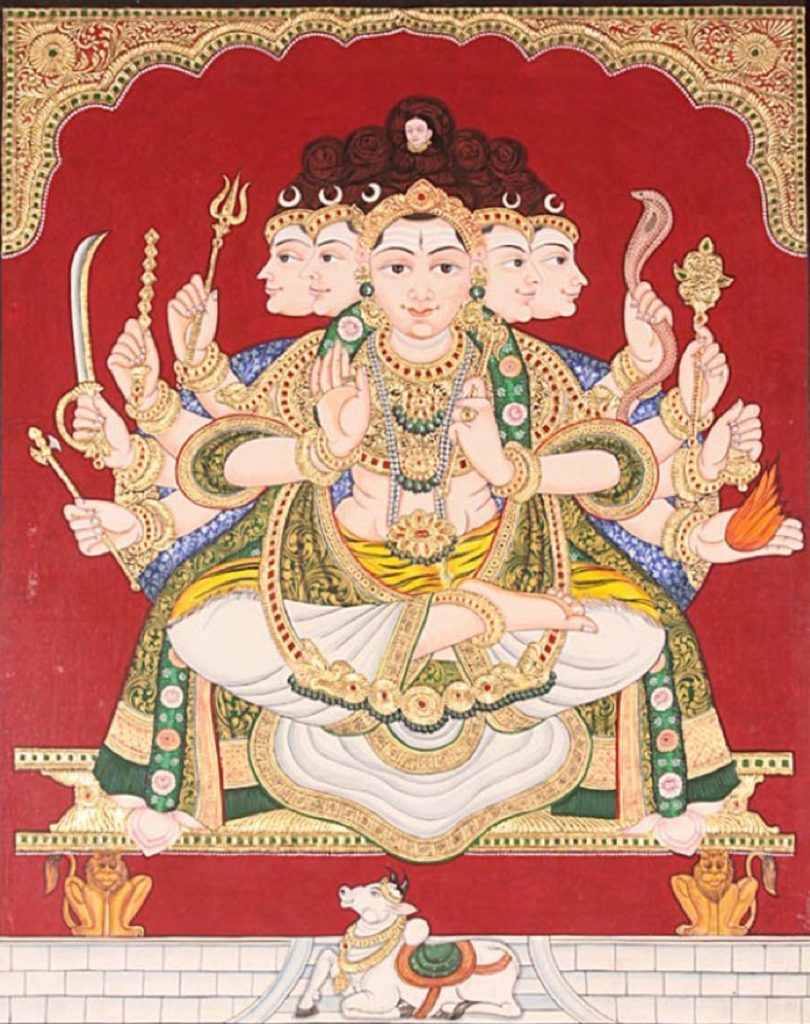
THE GREATNESS OF KARMA SADAKHYA
It has already been said that Karma Sadakhya appears in the form of Sivalinga, the combined form of Linga and pedestal. Now it is to be noted that the pedestal is constituted of five Aparabindu Kalas–Shantyatita and others. The Linga portion is constituted of five Aparanada Kalas–Urdhvagamini and others.
Parasiva is vibrantly present in the Siva Sadakhya. The presence of Parasiva and Siva Sadakhya is in the Amurti Sadakhya. In the Murti Sadakhya, there is the vibrant presence of Parasiva, Siva Sadakhya and Amurti Sadakhya. The presence of these four is in the Kartru Sadakhya. The vibrant presence of all five–Parasiva, Siva Sadakhya, Amurti Sadakhya, Murti Sadakhya and Kartru Sadakhya–is in the Karma Sadakhya, the final phase in the order of pure creation, manifesting in the form of the Sivalinga.
Karma Sadakhya is also the beginning phase in the order of non-transcendental creation. It is the repository for the group of transcendental tattvas, such as Paranada, Parabindu, Aparanada and Aparabindu. At the same time, it is the source for the evolution of 36 tattvas leading to this physical level. It is in Karma Sadakhya that the manifestation of Panchabrahma is taking place. The order of such manifestation is explained now.
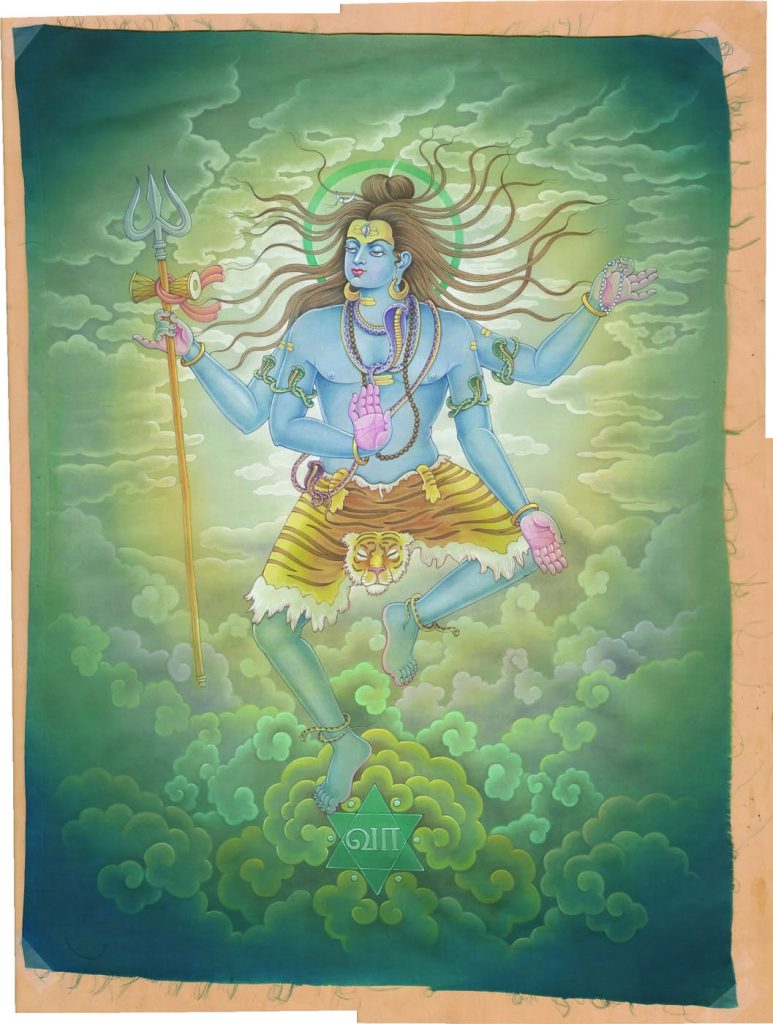
that wields the power of obscuration. His direction is east, He is related to the sphere
of air (vayu mandala), and His Panchakshara Mantra syllable is Va. The Agamas describe
Tatpurusha Deva as gold in color, dressed in yellow silken cloth, head adorned with a crown
and crescent moon. In one hand he holds a string of beads and in another His trident staff.
TATTVA, MURTI, PRABHAVA
Before introducing the process of manifestation of five great Lords (Ishana and others), it is essential to know about three categories: tattva, murti and prabhava.
The five Sadakhyas come under the category of tattva. Tattva means that which is existing from the time of creation, operating in an orderly way, and which is absorbed into its source at the time of final dissolution.
In the category of murti, there are five–Sivatara, Isha, Brahmisha, Ishvara and Vyomesha. Who are these murtis? Where do they come from? [Note: In the Agamas, Sivatara is more often called Sadasiva, and Vyomesha is known as Ishana.] These five murtis manifest along with the five Sadakhyas from the same source, but they remain latent within the Sadakhyas.
Sivatara lies latent within Siva Sadakhya. (Parashakti is dominant in Siva Sadakhya, and Anashrita [Siva aspect] is dominant in Sadasiva.) Likewise, Isha lies latent within Amurti Sadakhya. (Adishakti is dominant in Amurti Sadakhya, and Anatha is dominant in Isha.) Brahmisha lies latent within Murti Sadakhya. (Icchashakti is dominant in Murti Sadakhya, and Ananta is dominant in Brahmisha.) Ishvara lies hidden within Kartru Sadakhya. (Jnanashakti is dominant in Kartru Sadakhya, and Vyomarupa is dominant in Ishvara.) Vyomesha lies hidden within Karma Sadakhya. (Kriyashakti is dominant in Karma Sadakhya, and Vyapaka is dominant in Vyomesha.)
On the upper portion of the Sivalinga, Sivatara is present. Isha is on the west, Brahmisha on the north, Ishvara on the south and Vyomesha on the west.
Prabhava is the category of Panchabrahma (five-fold God), or Sadasiva, which comes into existence upon the union of tattva (Shakti aspect) and murti (Siva aspect).
PANCHABRAHMA
The union of Siva Sadakhya and Sivatara results in the appearance of Ishana. The union of Amurti Sadakhya and Isha gives rise to Sadyojata. The union of Murti Sadakhya and Brahmisha results in the manifestation of Vamadeva. The union of Kartru Sadakhya and Ishvara gives rise to Aghora. The union of Karma Sadakhya and Vyomesha results in the manifestation of Tatpurusha. All these manifestations are taking place in the Karma Sadakhya, which contains all prior levels of devolution.
Ishana is the source of spontaneous grace directed to all beings and to all worlds. It is beyond all systems and disciplines, unexcellable and unsurpassable, without limit or boundary.
Tatpurusha is the all-pervasive power that sustains the bodies of human beings, celestial beings, asuras, animals, birds and so forth, that which fills up and regulates the entire range of worlds, spreading out everywhere through nada arising from bindu.
Aghora is pure consciousness (Sivajnana), always calm and tranquil. It is the force that opposes the dreaded phenomenon of repeated birth and death, remaining ever aware in consciousness.
Vamadeva is the absolute power of knowing all and doing all, the force which keeps embodied souls engaged in activities to work out their karmas. It is the subtle and secret power, the luminosity of Siva, that enables embodied souls to experience dharma, artha and kama.

Sadyojata is the power that, by its mere will, assumes innumerable forms quickly and instantaneously creates relevant bodies for souls and relevant mantra-forms for competent yogis.
SADASIVA LINGA–THE FORMLESS AND THE FORMED STATE
The Sivalinga enshrined in the sanctum sanctorum is actually the form of Karma Sadakhya. The formless and transcendental Parasiva occupies this Sivalinga in the form of Sadasiva, or the Panchabrahma. The Agamas provide this description: “Sadasiva appears with five faces: Ishana, Tatpurusha, Aghora, Vamadeva and Sadyojata. The Ishana face, crystal in color, is at the top, looking upward. Tatpurusha, whitish-yellow, is turned eastward. Aghora, blue-black in color, is turned south. Vamadeva, of saffron hue, looks north. Sadyojata, colored like the moon’s rays, looks west. The overall form of Sadasiva is the color of crystal. Each face has three eyes. The five heads are adorned with a crescent moon and locks of matted hair bound together with serpents.”
FIVE MANTRAS THAT CONSTITUTE THE FORM OF SADASIVA
In addition to the five faces, the Panchabrahmas also assume the form of five mantras to constitute all other parts of Sadasiva’s body–heads, chest, shoulders, legs and so on. Each mantra is associated with vibrant shaktis known as kalas (pronounced kalās).
At this stage, Ishana becomes the mantra Ishana Murdha. Ishana marks the ultimate limit or boundary; hence Ishana Mantra is considered to constitute the heads of Sadasiva, the upper limit of the form. Murdha means head.
Tatpurusha becomes the mantra Tatpurusha Vaktra, constituting the five faces of the Lord. The term vaktra means to protect and to drive away. This mantra protects the bodies of all beings by bestowing knowledge and warding off the fear of future birth and death.
Aghora becomes the mantra Aghora Hridaya. It constitutes the heart, chest and related parts of the form. In this context, hridaya means supreme consciousness. This mantra metes out an antidote to the dreadful (ghora) phenomenon of repeated birth and death; thus it is known as aghora, meaning non-dreadful, tranquil and calm.
Vamadeva becomes the mantra Vamadeva Guhya. By nature, Vama is secret and unseen (guhya), the power of knowing and doing. It maintains progeny and related activities. Vama, meaning beautiful, also means base or inferior. The experiences of dharma, artha and kama are inferior to liberation. Vamadeva mantra enables souls to undergo lesser experiences in order to nullify their karmic merits and demerits. This mantra is considered to constitute the private parts (guhya) of the body–the hips and other lower regions.
Sadyojata becomes the mantra Sadyojata Murta (murta meaning form). Sadyojata is capable of assuming innumerable forms quickly, pervading and spreading. For this, feet are necessary. Not only feet, but the whole form is required to move. Thus Sadyojata mantra constitutes the limbs of the body.
PANCHABRAHMA AND THE FIVE DEPUTED LORDS: BRAHMA, VISHNU, RUDRA, MAHESHVARA AND SADASIVA
For the Supreme Lord Parasiva, the main purpose of descending to the level of Karma Sadakhya is to perform the cosmic activities within the realm of pure maya. He does this through His form of Lord Sadasiva (or Panchabrahma). The five cosmic activities are: creation, maintenance, dissolution, concealment and bestowal of grace. Siva’s power of creation is Sadyojata. The power of dissolution is Aghora. Tatpurusha is Siva’s power to veil the soul’s inherent nature (of Pure Consciousness and its infinite power of knowledge and action). Siva’s power of revealing grace is Ishana. The Vedas and the Agamas are revealed through the five faces of Sadasiva.
Sadasiva exists at the extremely rarefied stratum of pure maya (the causal plane) and therefore cannot be directly involved with impure maya (the astral and physical realms). So, He performs the five actions in these realms through five Deputed Lords (Adhishtita, also known as Karaneshvara): Brahma, Vishnu, Rudra, Maheshvara and Sadasiva. [Note: The Deputed Lord Sadasiva is set in italics to distinguish it from Sadasiva, the synonym for Panchabrahma.]
So, the cosmic process of hypostasis takes place and directly from Karma Sadakhya arises Sadasiva, the first deputed Lord, and then Maheshvara (as one thousandth part). From Maheshvara arise Rudra (one thousandth part), Vishnu (one 10 millionth part) and Brahma (one 10 millionth part).
Brahma is deputed for the activity of creation under the direction of Sadyojata, its Controlling Lord (Adhishtatru); Vishnu protects as directed by Vamadeva; Rudra reabsorbs as directed by Aghora; Maheshvara conceals as directed by Tatpurusha; Sadasiva bestows grace as directed by Ishana.
ADHO MUKHA, THE SIXTH FACE
In addition to the five faces of Sadasiva, there is a sixth face named Adho Mukha, which manifests out of a sixth Sadakhya, Maha Sadakhya, and looks downward. A pleasant blue color and located at the neck of the Lord, it is associated with Sri Nilakantha, the blue-throated Lord. Most of the esoteric meanings of Aum, the Pranava, are connected to Adho Mukha. It is identical with the space of supreme consciousness (chidakasha) and generates five levels of akasha. Adho Mukha has its role and presence in the form of Lord Skanda.
SADASIVA IN TEMPLE WORSHIP RITES
During the puja, the priest visualizes the form and limbs of the Deity while chanting the respective five Panchabrahma Mantras three times. Perhaps the most significant instance is the invocation of the Divine presence into the Sivalinga: Ishana corresponding to the head; Tatpurusha, the face; Aghora the heart and chest; Vamadeva, the hips and other lower regions; and Sadyojata, the limbs. While chanting each mantra, the priest touches the corresponding place on the Sivalinga, from the top down to the base of the pedestal. Following that, the priest visualizes the corresponding five kalas while chanting and invoking them into the parts of the Sivalinga. Thus, during puja, the Sivalinga serves as a microcosm into which is poured the macrocosm in all of its dimensions of existence.
Next the priest again chants the five mantras while offering flowers in worship of the various parts of the body of Sadasiva and then to the five aspects, or faces, of Sadasiva in association with the five krityas, cosmic actions or powers. The five krityas and corresponding Panchabrahmas are 1) srishti, creation, Sadyojata 2) stithi, preservation, Vamadeva; 3) samhara, dissolution, Aghora; 4) tirobhava, concealing grace, Tatpurusha; 5) anugraha, revealing grace, Ishana.
For the final arati, a profound mantra from the Taittiriya Aranyaka, known as the Panchabrahma Veda Mantra (see below), is chanted to invoke the five aspects of Sadasiva into each of the five flames while offering the arati lamp before the Sivalinga.
CONCLUSION
Congratulations! The Agamas themselves contain a disclaimer for this arcane discussion: “This is the ultimate subject. There is no subject superior to this. Since it is ultimate, it cannot be understood by the uninitiated. Even for the initiated, there is no sadhana superior to understanding this ultimate subject. It is actually a great tapas (austerity) to meditate on this ultimate subject.” Vatula Agama, Tattvasara Patala, 252-254
1. Sadyojata (“quickly birthing”), the controlling Lord of Brahma, is the aspect of Siva that wields the power of creation. His direction is west, He is related to the sphere of earth (prithivi mandala) and His Panchakshara Mantra syllable is Na. The Agamas describe Him as white in color, in the likeness of a boy with a charming face, besmeared with sandalwood paste, adorned with white flowers. One hand displays the boon-granting varada mudra and another the fear-not abhaya mudra. He is Siva manifest in all of nature; the causer of birth.
2. Vamadeva (“lovely, pleasing”), the controlling Lord of Vishnu, is the aspect of Siva that wields the power of preservation. His direction is north, He is related to the sphere of water (jala mandala), and His Panchakshara Mantra syllable is Ma. The Agamas describe Him as red in color, with a handsome face and aristocratic bearing, wearing rich apparel, a turban and garlands of flowers. He holds a sword and a shield.
3. Aghora (“nonterrifying”), the controlling Lord of Rudra, is the aspect of Siva that wields the power of dissolution. His direction is south, He is related to the sphere of fire (agni mandala), and His Panchakshara Mantra syllable is Si. The Agamas state that Aghora Deva is the color of dark cloud and is adorned with crescent studded crown and beautiful earring. Though His expression is pleasant, His appearance is dreadful, with long, projecting teeth, and a tawny colored beard, moustache and matted hair. He is adorned with snakes and scorpions and a garland of skulls. The four hands on the left side hold a fire, khatvanga (a staff with a skull at its top), shield and noose. The four hands in the right side hold a trident, hatchet, sword and staff.
4. Tatpurusha (“supreme soul”), the controlling Lord of Maheshvara, is the aspect of Siva that wields the power of obscuration. His direction is east, He is related to the sphere of air (vayu mandala), and His Panchakshara Mantra syllable is Va. The Agamas describe Tatpurusha Deva as gold in color, dressed in yellow silken cloth, head adorned with a crown and crescent moon. In one hand he holds a string of beads and in another His trident staff.
5. Ishana (“ruler”), the controlling Lord of Sadasiva, is the aspect of Siva that wields the power of revealment. His direction is upward, He is related to the sphere of ether (akasha mandala), and His Panchakshara Mantra syllable is Ya. The Agamas describe Ishana Deva as pure crystal in color, with three eyes. In one hand He holds a trident and in another a string of beads. His two other hands present the abhaya (“fear not”) and dhyana (meditation mudras. Bearing a crescent on His crown, His form is charged with benevolence.
GAURI LATA MANDALA
The meaning of the term mandala, as given in the Agamas, is “the square, the interior of which is enriched with various geometrical designs and beautified with colors.” According to the Agamas, square is the basic form from which all other forms appear and into which they merge. In the yagnashala of a temple, a mandala is worshiped to channel the effects of the fire-ritual (oblations) and to enhance the auspiciousness of the surroundings. It is to be placed between the fire pit and the main altar (vedika). Though mandalas are not meant for meditation, the display of a perfectly designed mandala in a hall or shrine will ensure the divinity of the place and ward off any negative forces. Mandalas are of two kinds–those meant for use in temple rituals and those to be displayed in places of learning, hospitals, libraries and such. Mandalas consist of various important parts which correspond to various parts of a standing body, such as face, torso, hands, legs and so on. A mandala is actually a three-dimensional image rendered in two-dimensional form. The most important aspect of a mandala is its coloring. Each letter, each word of a mantra, each tattva, each kala, each form of a Deity, each of the vital airs of our body, each nadi (channel of the body), each element of the universe has its own significant color. Based on this concept, the guru who has a perfect knowledge of these principles and colors designs a particular mandala. The design of a mandala is based on the nature of a particular Deity to which that mandala belongs. Lord Sadasiva, five Sadakhya Saktis, Ashta Murtis, Ashta Vidyesvaras, Ashta Devatas (Nandi and others) and all the 36 tattvas are represented in the Gauri Lata Mandala.
Sabharathnam Sivacharyar
PANCHABRAHMA IN SHAKTISM & VAISHNAVISM
The five Panchabrahma murtis are found not only in Saivism, but also in Shaktism and Vaishnavism. They are portrayed in various forms depending on the tradition one follows. The Saiva Agamas depict them as: 1) Sadyojata, 2) Vamadeva, 3) Aghora, 4) Tatpurusha and 5) Ishana. In the Shakta tradition they are: 1) Brahma, 2) Vishnu, 3) Rudra, 4) Ishvara and 5) SadaSiva. In the Vaishnava Agamas, they are named: 1) Vasudeva, 2) Samkarshana, 3) Pradyumna, 4) Aniruddha and 5) Narayana.
The concept of Panchabrahma in the Shakta school of thought could be best summarized by the most revered text of the Sri Vidya tradition, Sri Lalitha Rahasya Sahasranamam, the thousand names of Lalita Mahatripurasundari. Names 249 and 250 are Panchapretasanasena and Panchabramaswarupini. The meaning is that Sri Lalitha, seated on Her throne consisting of the Panchapretas, or five lifeless bodies (the five elements), is responsible for bringing existence to these Panchabrahmas through the infusion of Herself, the Shakti (pure energy).
Scientifically, it is understood that everything in the universe is made up of two things: matter and energy. Matter represents Siva and energy represents Shakti, and it is through this mergence that the manifestation of this universe exists. In Shaktism, the Panchabrahmas are responsible for the execution of the panchakrityas, or five-fold acts: 1) srishti, creation of the universe; 2) sthithi, sustenance of the universe; 3) samhara, destruction of the universe; 4) tirodhana, concealment; and 5) anugraha, absorbing the soul into infinite bliss. Understanding this, the aspirant must acknowledge that in order for life to continue, Siva can never be separated from Shakti; so we realize and revere Her as Panchabramaswarupini.
Janahan Balasingham
THE PANCHABRAHMA VEDA MANTRA
One of the greatest and most sacred of all mantras, the Pañchabrahma Mantrāṇī, is found in the Kṛshṇa Yajurveda, Taittirīya Āraṇyaka 10.17-21. Here its five verses are cited in reverse order (21 to 17), just as they are chanted during puja. This is a lucid translation by Sabharathnam Sivacharyar, based on the 12th-century translation by Ugrajyoti Sivacharyar in his priestly manual Vedartha Nirnaya Manjari, giving the enhanced meaning of the mantras in the context of the Saiva Agamas.
ईशानस्सर्वविद्यानां ईश्वरस्सर्वभूतानां ब्रह्मािधपतिर्ब्रह्मणोऽधिपतिर्ब्रह्माशिवो मे अस्तु सदाशिवोम्।
īśānassarva vidyānām īśvaras sarva bhūtānām brahmādhipatir brahmaṇo’dhipatir brahmā śivo me astu sadāśivom
Lord Ishana—the Supreme Lord and Revealer of all knowledge and spiritual disciplines, the nourisher and controller of all living beings, the Directing Lord of Sadasiva, He who is the guiding and directing authority for the eight Vidyeshvaras, who directs Brahma, Vishnu and others—may He present Himself in this Sivalinga. By such benign presence, let there occur absolute purity and auspiciousness in me. Om.
तत्पुरुषाय विद्महे महादेवाय धीमहि तन्नो रुद्रः प्रचोदयात्।
tatpurushāya vidmahe mahādevāya dhīmahi tanno rudraḥ prachodayāt
As guided by my guru, I realize the form of Siva known as Tatpurusha. I meditate with pure mind and refined intellect on the Great Illuminator. Let Tatpurusha—who cuts asunder the limiting bonds of the souls and by this act comes to be known as Rudra—guide, enlighten and strengthen my organs of knowledge and action and my internal faculties.
अघोरेभ्योथघोरेभ्यो घोरघोरतरेभ्यः सर्वेभ्यस्सर्व सर्वेभ्यो नमस्तेऽस्तु रुद्ररूपेभ्यः।
aghorebhyotha ghorebhyo ghora ghoretarebhyas sarvebhyas sarvasarvebhyo namaste astu rudrarūpebhyaḥ
Salutations to Lord Siva who manifests Himself in countless benign forms, in frightful and terrifying forms, and to all those countless forms of Rudra (eulogized in the Sri Rudram hymn). Salutations to all such manifestations of Lord Siva.
वामदेवाय नमो ज्येष्ठाय नमः श्रेष्ठायनमो रुद्राय नमः कालायनमः कलविकरणाय नमो बलविकरणाय नमो बलाय नमो बलप्रमथनाय नमस्सर्वभूतदमनाय नमो मनोन्मनाय नमः।
vāmadevāya namo jyeshṭhāya namaḥ śreshṭhāya namo rudrāya namaḥ kālāya namaḥ kalavikaraṇāya namo balavikaraṇāya namo balāya namo balapramathanāya namas sarvabhūta damanāya namo manonmanāya namaḥ
Salutations to the luminous Lord who sportively creates everything. Salutations to the One who is eternally the Eldest, transcending the great cycles of time. Salutations to the One whose lordship excels all other Gods. Salutations to the One who wards off the sufferings of all living beings. Salutations to the One who is Eternal Time. Salutations to the One who sets into operation the divisions of time and maintains the worlds in an orderly way. Salutations to the One who, being the source of strength, strengthens the auspicious forces. Salutations to the One who, being the wielder of strength, withdraws the strength of inauspicious forces and extirpates them. Salutations to the One who guides all souls to ultimately reach Him.
सद्योजातं प्रपद्यामि सद्योजाताय वै नमो नमः। भवे भवेनातिभवे भवस्वमां भवोद्भवायनमः।।
sadyojātaṁ prapadyāmi sadyojātāya vai namo namaḥ bhave bhavenātibhave bhavasva māṁ bhavodbhavāya namaḥ
I submit my mind, speech and body totally and repeatedly to Lord Sadyojata, who manifests Himself and instantaneously creates bodies and worlds, who appears to devotees in the forms contemplated by them and yet transcends such forms assumed by Him and who has a retinue of Deities formed of millions of mantras. May He make my form as of His own form.
